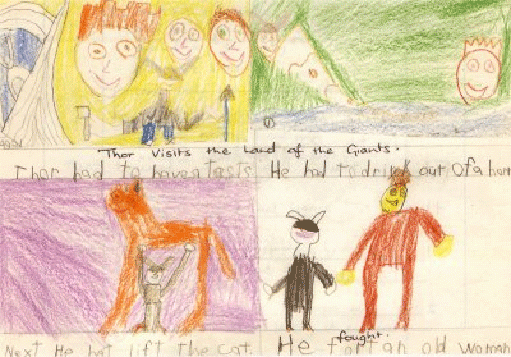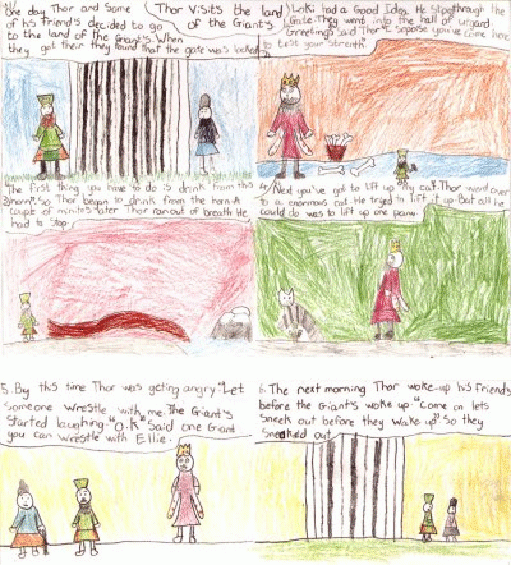Learning to Write
Stages of Childrens Writing
In the early stages of learning to write and read, young children compose before they know much about the conventions of writing and reading or have the skill to control a pencil or crayon or form letters.
Children in preschool often write and read in unconventional forms: scribblings, drawings, letter-like marks. These are not mistakes. Young children are encouraged to ‘write’ without worrying about the mechanics of writing.
Dr Kathy Barclay has identified seven stages of children’s writing. (1996).
- 1. The first stage is SCRIBBLING.
These are random marks on a page. To encourage children at this stage, adults can offer blank paper and writing tools and talk with children about their writing.
- 2. The second stage is MOCK HANDWRITING.
This often appears with drawings. Children produce lines of wavy scribbles. This stage resembles cursive writing and may be revisited at a later time.
- 3. The third stage is MOCK LETTERS.
Children make letter-like shapes that resemble conventional alphabet letters.
- 4. The next stage is CONVENTIONAL LETTERS.
The first word to appear is usually the child’s first name. Adults will often see a string of letters across a page that a child reads as a sentence.
- 5. This is known as the INVENTED SPELLING stage.
As the child writes conventional letters, they begin to cluster letters to make words. Although the words may not appear conventional, children will often ask an adult, “What did I write?”
- 6. Stage six is the APPROXIMATED OR PHONETIC SPELLING stage.
Children begin to associate sounds with the letters.
- 7. The last stage of writing is the CONVENTIONAL SPELLING stage.
This occurs as the child’s approximated spellings become more and more conventional.
Functions of Writing
Writing has the following FIVE FUNCTIONS; Children have to learn the functions of writing.
1. Practical
Most of us make lists, jot down reminders, write notes and instructions.
2. Job related
Professional and white collar workers write frequently.
3. Stimulating
Writing helps to provoke thoughts and organise them logically and concisely.
4. Social
Most of us write thank-you notes, invitations and letters to friends occasionally.
5. Therapeutic
It can be helpful to express feelings in writing that cannot be expressed so easily by speaking.
Stages of Writing Development
Learning to write is much more than a motor skill. It can be studied in conjunction with children’s emerging cognitive, social and linguistic abilities.
Being able to write enables children to formulate thoughts and reflect on meaning – it is part of the PROCESS of learning.
In addition to motor ability and functional awareness, children need to develop the structures of language appropriately.
Kroll (1981) – recognised 4 stages of development:
Preparatory stage (approx. 4-7)
- Basic motor skills develop and principles of the spelling system acquired.
Consolidation stage (approx. 7-9)
- Children begin to use writing to express what they can already say in speech. Writing closely reflects the patterns of spoken language. There may be colloquialisms, strings of clauses linked by “and”, unfinished sentences.
Differentiation stage (9+)
- Writing begins to diverge from speech and develops its own patterns and organisation. Errors are common at first, as children learn new standards and experiment with new structures found in their reading. Their written work becomes fuller and more diverse as they encounter the need to produce different kinds of writing for different audiences and purposes.
- At this point children need guidance about the structures and functions of written language.
- They realise that writing is a medium where there is time to reflect, re-think and to use language as a way of shaping thought. They therefore begin to draft/revise/edit.
Integration stage (14+)
- Writers have such a good command of language that they can vary their stylistic choices at will and develop a personal ‘voice’. This continues to develop throughout adult life.
Features of the English Writing System
- Holding and controlling the pen.
- Direction of writing – writing goes from left to right.
- Alignment of writing – writing goes along a straight line.
- Using upper and lower case.
- Spacing words appropriately on the line/page.
- Understanding and applying principles of sentence construction.
- Understanding and applying the conventions of punctuation.
- Letter direction – many letters face in a particular direction, e.g. ‘b’ and ‘d’ as well as ‘s’.
- Selecting appropriate words and using appropriate graphemic combinations to spell them.
- Later, learning to produce cursive (joined-up) script.
- Learning and using forms and conventions for genres of writing e.g. letters, stories.
- Using the skills of reassessing to monitor and correct the writing as necessary.
Children's Writing
|
STAGE |
DESCRIPTION |
ANALYSIS |
|
1. Drawing & sign writing |
· Children often experiment with a kind of sign writing which they regard as being different from drawing. · Beginning to understand that we use marks on the page to pass on ideas from writers to readers. · Signs show some characteristics of writing on the page, such as a succession of characters in a line. |
The first breakthrough comes when children learn to recognise that there is a difference between drawing and writing - between shapes & signs. They grasp that writing (in English) is distributed along straight lines and that direction (from left to right) mattes. They learn that the distribution of blank space is also important. |
|
2. Letter-like forms |
· Individual signs produced have some letter-like features. |
Children start to recognise the different shapes for the alphabet & copy these. This is a difficult task Q of |
|
3. Copied letters
|
· Child is able to overwrite, underwrite or copy letters sufficiently accurately for them to be recognised. |
the number of different upper & lower case letters & importance of minute distinctions relating to their relative size, orientation & position in relation to the line. They learn to associate these with different sounds or names. A second difficulty arises from the fact that the same letters in English can represent different sounds in different contexts |
|
4. Child’s name & strings of letters |
· Child independently writes strings of letters, usually including their own name. |
Children start to recognise that groups of letters tend to occur together. Many first learn this in connection with their own name. Usually, they learn it as a sight-word without at first being able to analyse it into letter components. They also begin to recognise that other words they come across frequently have the same strings of letters at the beginning and at the end. |
|
STAGE |
DESCRIPTION |
ANALYSIS |
|
5. Words |
· Children learn that the sounds associated with groups of letters represent familiar spoken words. · Understanding of the principles underlying the use of the alphabet. |
Breakthrough to literacy comes when the child learns to associate the sounds linked to groups of letters with spoken words they know. They have understood the alphabetic principle - that we can approximately represent the sounds of words using letters. When children reach stage 5, the threshold to literacy has been crossed. |
|
6. Sentences |
· Children have learnt to write confidently. · Can begin to express ideas in writing that link several concepts. · Need to use clause or sentence to do this. · Do this without using capital letters and full stops systematically. |
Children have to learn the conventions we use to show how groups of words are linked together into sentences; but the systematic use of grammatical punctuation, including full stops & a capital letter to start a sentence is something that almost always occurs after children have begun to write texts fluently. |
|
7. Text |
· Writing texts involves combining clauses or sentences to express related ideas. |
Children learn to combine clauses & sentences into texts to convey a sequence of related ideas. Texts are defined as writing involving a series of related sentences. Texts are coherent in meaning and cohesive in structure - not just a list of unconnected sentences. |
Developmental Stages of Spelling
There are several different but parallel systems that break down the developmental stages of spelling into understandable categories. This one uses four stages although there are perfectly good systems divided into six and eight categories.
Stage One: Exploration
- Pre-letter writing.
- Random writing on page -letters, symbols, numbers.
- May use repetition of familiar letters such as the letters in child's name.
- Uses left-to-right directionality.
- Uses random sight words.
Stage Two: Semiphonetic
- Leaves random spaces in writing.
- Uses a few known words in correct place - i.e. names.
- Shows letter-sound correspondence.
- uses initial consonants.
- uses partial mapping of word (2 or 3 letters).
Stage Three: Phonetic
- Total mapping of letter-sound correspondence.
- Vowels are omitted when not heard.
- Writes quickly.
- Spaces words correctly.
- Letters are assigned strictly on the basis of sound br=bar or prt=party.
Stage Four: Transitional
- Vowels appear in every syllable.
- Silent "e" pattern becomes fixed.
- Inflectional endings like "s", "ing" are used.
- Common letter sequences are used (ay, ee, ow).
- Child moves toward visual spelling.
- May include all, but reverse some, letters (from=form).
A Framework for Talking about Children’s Writing
|
In your introduction you should describe the text overall, paying attention to pragmatics and discourse:
|
|
Consider the lexis of the text:
|
|
Consider the grammar of the text:
|
|
Consider the graphological features of the text:
|
|
Consider the spelling of the text:
|
CHILDREN’S WRITING SAMPLES
Look at the following two pieces of children’s writing. For each piece write a commentary using the frameworks to guide you. When you have finished, read the commentaries that follow.
Sample 1

Sample 2

Commentaries
Sample 1
Nathan's work shows that he can recall ideas from a story that has been read aloud to him. For example, he is able to write appropriate captions for the Norse legend, using the planned structure and pictures to help him.
Although each caption makes sense on its own, there is no sequential link between the statements; even the work 'Next' as the introduction to one sentence does not full clarify which picture follows which. While there is some integration of words and pictures, Nathan's writing does not yet show the use of a narrative form, nor an awareness that the person reading the story needs to have some introduction to the characters, and a sense of why the events are taking place.
Nathan's work reveals some understanding of the need to use full stops at the end of sentences, and of the link between capital letters and sentence punctuation.
Many words are correctly spelt, most letters are correctly formed and spacing between words is good.
Sample 2
The picture caption format invites succinct writing, and Annie shows an ability to select the main elements of the tale while also giving the reader enough detail to follow the story. The picture frames help to structure the writing into coherent paragraphs.
Annie captures the interaction of the characters by using direct speech. The narrative commentary indicates feeling and motives ('Loki had a Good Idea', 'By this time Thor was geting angry').
She applies her knowledge of the language of time to structure events and move the story forward ('The first thing... Next you've got to... By this time... The next morning').
Some imaginative phrases are used which create a lively sense of the action and sustain interest ('ran out of breath', 'enormous cat', 'all he could do was to lift up one paw', 'wrestle', 'sneek out').
Punctuation is accurate and Annie occasionally uses an apostrophe, although this is sometimes confused with plurals (giant/giant's). Dialogue is punctuated to identify speakers and the captions provide interest for the reader. Although her handwriting is not joined, it is clear and fluent.
